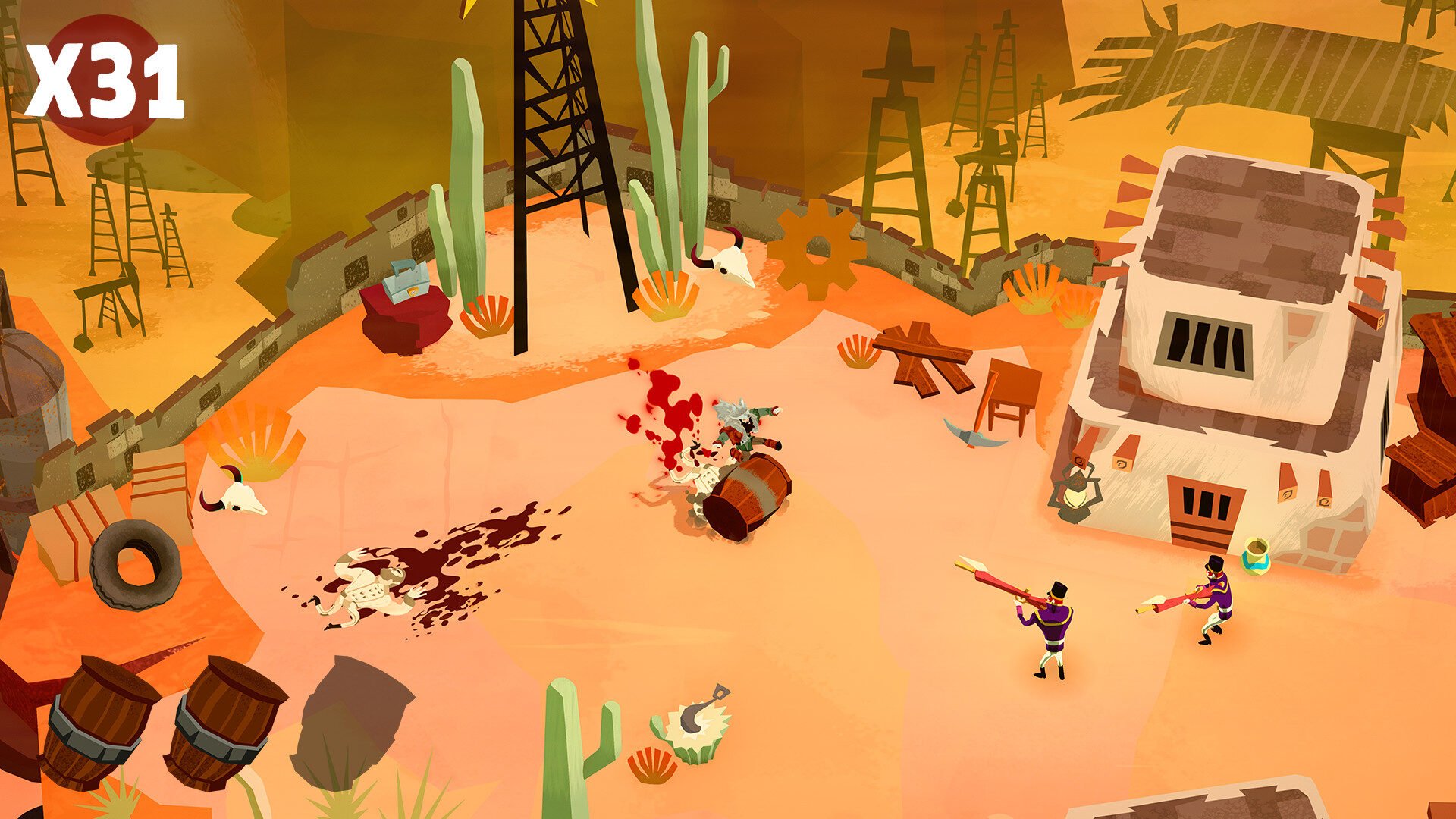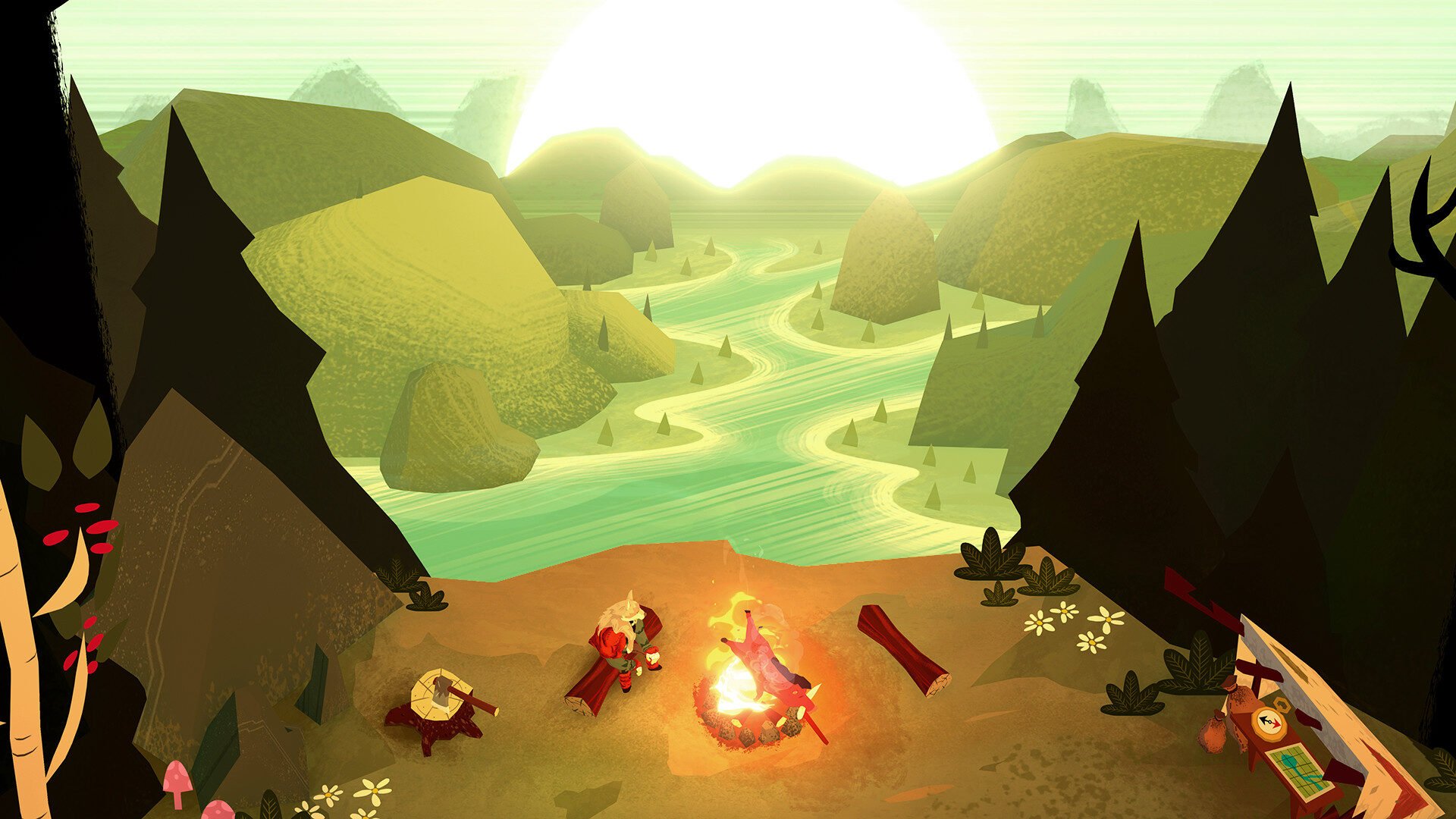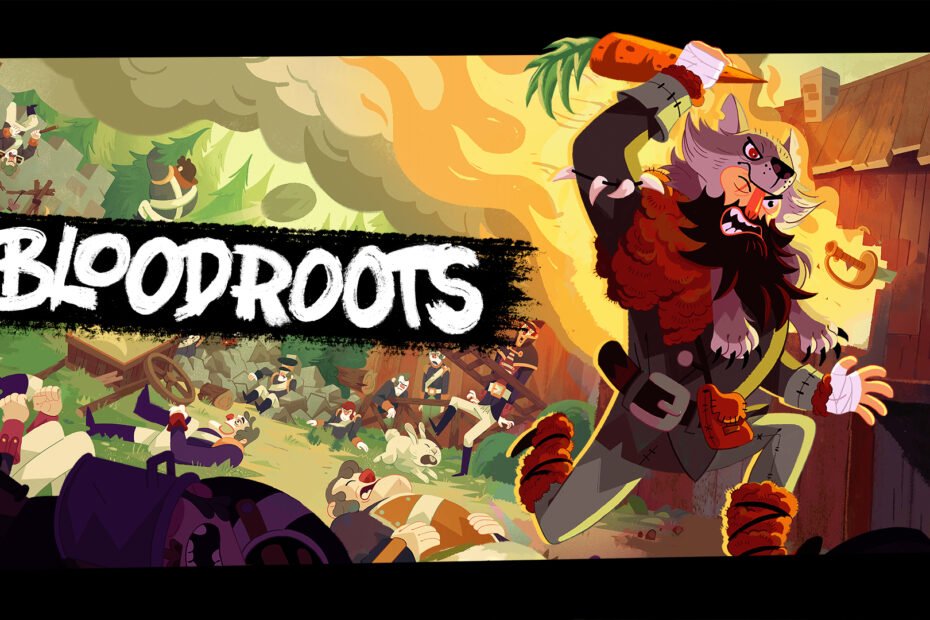Bloodroots opens itself to the obvious Hotline Miami comparison immediately, perhaps from the title and cover art alone. In a way, it’s refreshing to know exactly what type of experience to expect with such immediacy; there’s no mystery to uncover, no potential for a bait and switch, and if you’re in the mood for a hyper violent brawler, you need not look past its veneer.
What’s most impressive about Bloodroots, however, is that despite its close treading of the ground once imprinted by Dennaton with their gory 80’s inspired murder mania, it’s entirely its own thing, one which plays notably different while retaining the tight, responsive controls we loved, and in some ways surpasses Hotline Miami through increased simplicity and, therefore, accessibility.
The time period of Bloodroots is never revealed, but it’s evidently set in a time where death by murder was a common, accepted fact of life. Some of the audio and environments evoke the tone of a western, while the Nordic bitter cold and evocations of pelt-wearing marauders place it in a time far more distant. The infamous “Blood Beasts” comprise of four dispicable dangers to whatever society exists in this world: Mr Wolf, Mr Boar, Mrs Bison and Mrs Crow. We play as the former, now separated from the group on the grounds of succumbing to their murderous hands. Somehow “alive”, we travel the land hunting the other three clan members, along with a so-called “Mr Black Wolf”, which as we quickly realise is less tangible than the meaty and very much living beasts.
With Bloodroots rooted (ha…) in a time period before the drug-fuelled 80’s, a comparison to swipe away immediately would be the weapon arsenal, and more so the amount of weapons and where you can find them. Both melee and ranged weapons exist, with axes, swords, wood posts, carrots and the literal remains of those you’ve beaten to death with a carrot taking precedent early in, but ranged tools like pots, hay bales, snowballs and Captain America-style boomerang shields come into play significantly later on. Sheer variety trumps all here, to the point I almost couldn’t believe how many unique weapons existed. Like Hotline Miami, every weapon deals the same amount of damage, but their use cases vary immensely. Swords for example enable you to dash forward, acting equally as useful as a mobility tool as a murder weapon, while the humble bow and arrow exists in both categories, allowing you to ping off a range attack and then boop an enemy charging at you in retaliation. Some of the larger weapons like ladders allow you to leap into the air, gaining a vertical boost, while scythes can spin in mid air to gain a hover ability.
Most of these added boons are surplus to requirements, but the whole game’s focal point is excess and flair. Where Hotline Miami would excel at the raw, unadulterated euphoria of bursting into a room and slaughtering 8 dudes in less than a second, Bloodroots is focussed on jumping into an area having you ponder “how can I kill these 8 dudes in the funniest way possible?” You could slap a fish on a guys head, immobilising him, rip a post off a fence and use that to bludgeon another, grab some fireworks and blast a few of your victims to pieces and finish it all off by kicking a barrel into a conveniently placed row of enemies, squashing them all, leaving a saturated velvet paste in the snow.
That’s one similarity which rings true from start to finish though, the blood. Bloodroots, unsurprisingly, contains a lot of blood, and with a lot of the levels encased in snow, the violent core of the game is evinced toan extreme degree. It’s an integral theme to the story too – that of bloodlust and excessive violence – and similar to Hotline Miami the brutality is just as important visually as it is for the gameplay. Clearing an area in Bloodroots often plays out a little cutscene on the final kill which changes depending on which weapon you have equipped, and all of them are just as hyper violent as the combat itself. The merciless way you slash and bash through enemies, leaving them in a mess of entrails, furthers the main character’s sole characteristic as an unrelenting brute. Some might look at a game like this and just see excess – in the same way one might look at Hotline Miami – but, hopefully, with the sense that this is a video game, you can detach yourself from the heinous acts you execute and marvel at the artistry behind it.
Even more so when you consider how the game manages to balance such sinister material with levity, injecting humour through the more cartoony visuals and witty writing. The latter in particular surprised me for some reason. Once I understood what type of game Bloodroots was, I thought it would forgo serious narrative or even pithy and concise dialogue, but it doesn’t. In fact, the writing in Bloodroots ended up being one of my favourite parts of the game, as previously mentioned, constantly proving a source of comedy and/or a necessary suspension from the presumed perpetual violence. Characters like Mr Boar speak with eloquence and come from a background of affluence, while their profession as a dangerous criminal has them speak with a certain commonness to them, throwing in well placed profanities in humorous ways. If you add up all the lines of dialogue in what is a short game, there really isn’t that much. Therefore, I found it impressive that characters like Mrs Bison were given genuine character despite the brief narrative limelight they’re afforded. Mrs Bison, the youngest of the group, still retains part of her innocence, vacillating from blatant barbarian talk of pillaging villages and attaining the “Queen of the West title, suddenly snapping into childlike ignorance to the treachery she’s grown up with, asking questions to the other Beasts like a 5 year old asks “why?” to every mundane question.
Since this review is based so heavily on the contrast to Hotline Miami, a game whose narrative is deeply rooted in esotericism, Bloodroots’ more straightforward approach to storytelling was a welcome one, and another avenue for the game to distance itself from its clear inspiration. Bloodroots revolves around bloodlust and revenge so much you could replace Mr Wolf with Liam Neeson and I wouldn’t look twice. Mr Wolf utters only one line, repeatedly, yet through his actions, and words of others and through cutscenes, we come to understand the base destruction at the heart of his existence. He isn’t complex, but every element of the game goes some way to define his rugged and harmful life: the crimson trails of blood and fire left in his path, the way his toxic, criminal companions describe him as a pure chaos none of them exhibit nor envy, the single, ravenous sentence he replies to everything, “where is Mr Black Wolf?”. He is the ultimate beast, and his journey into self annihilation brings with it the annihilation of the world around him too, making for a compelling, if simple narrative, but also an addictive gameplay loop of death.

This is where the primary comparison to Hotline Miami stems from, and it’s the area of the game which sinks its teeth into you with the most haste: the combat. Hotline Miami was innovative in the way it made adrenaline filled top down shooters even more euphoric through the added difficulty of one shot kills, both to enemies and yourself. Bloodroots retains that DNA, for the most part. Outside of boss fights and the occasional enemy which takes two hits, Bloodroots is a game of indescribable speed and reaction-based brawling. I found Bloodroots settles into a flow more akin to a Dynasty Warriors game than Hotline Miami, in the sense it feels more intent on empowering the player in the most satisfying way possible, where it’s inspiration balances the split second combat encounters with careful planning and perfectly executed routines. Bloodroots is all about its aforementioned arsenal, in my opinion. It’s something which diversifies and intensifies with every level, rising from the more prosaic swords and axes to weapons of legend and silly gag weapons which still prove useful. In some way you can say Bloodroots isn’t as difficult because of this. I certainly found it was a more meditative experience than pure challenge, as it was something I could turn on for ten minutes and just have a blast finding weapon combos which elicited the most laughs. That was something hard to do in Hotline Miami, a game which felt more rigid in how it wanted you to complete a level, feeling more puzzle-like than pure action.
Bloodroots is almost pure action; a gory, goofy and explosive sandbox with plenty of different routes for success. It works due to the solid foundations. Controls are tight, with no slack in sight. Attacks come out instantly, enemies die milliseconds after a button press, and generally speaking the game does little to get in the way of pure fighting. It’s not a cake walk by any means. I died plenty of times – although as I’ll discuss I’m not sure all of them were warranted – and some encounters do play out in more of a puzzle-like fashion, having you overcome the odds in the one way the developer intended for you to. By and large though, Bloodroots offers the same experience a five star wanted level in Grand Theft Auto does: pure carnage.
The camera system used in Bloodroots is far more dynamic than you’d expect. Most of the time, it will fluctuate between minute changes in angles, all from a top down perspective. Occasionally, you’ll view the action soaring far above the norm, letting you take in the entire scene like an eagle, other times it will pan down towards Mr. Wolf’s profile and the game suddenly switches to a 2.5D style. It’s impressive from a cinematography perspective, and in the latter’s it’s a genuine treat to play the same game from a unique viewpoint. That said however, the typical camera preset, along with the visual design of the landscape, caused some issues for me with platforming, resulting in the “unfair deaths” I alluded to. Sometimes I wished I could manually pan the camera myself, as quite often it’s hard to tell where a never ending pit begins and where a ledge ends. Some platforming elements are designed around a challenge, and as such require accurate timing of your jumps, which sometimes led to irritating deaths which I felt could have been avoided by edges being highlighted more clearly.
My only other complaint with Bloodroots comes in the form of its soundtrack, which never quite matched the tone of the rest of the game. I can best describe it as partly “western-y”, partly Miami, which might sound half-apt given my prior description of the time period, but it’s worth highlighting how Bloodroots’ setting feels distinctly different from a traditional western, almost in an alternate dimension. This was the second time in a row my partner even commented how the audio isn’t matching the game, made more apparent by tracks like “Party” and “Hatchet Kill” which sound desert themed, infused with elements of electronic music. The obvious link to make here is to Hotline Miami, more accurately how that game used its soundtrack perfectly to evoke the players’ raging adrenaline. Here however, lacking the drug-fueled themes of that game results in the soundtrack sounding discordant and detached from the finished product.
It’s a minor complaint in the grander scheme of things, because the gameplay alone pumps blood around your body faster than a trashy EDM track. While those moments of anger caused by untimely and (in my opinion) unwarranted deaths will always stick with me, so will the times I blasted through an area at a pace speedrunners would be envious of, or the pure joy I felt executing a combo I thought would never work, or just the simple pleasures of listening to th e ghosts of your fallen “companions” toss scornful yet witty remarks at you next to a campfire. I’d say Bloodroots is mightily derivative; I think it’s impossible not to be when a single video game pioneered a subgenre in the way it did. But it’s irrelevant, because Bloodroots is a rarified romp, rivalling the progenitor for the crown, and it just might snatch it.

